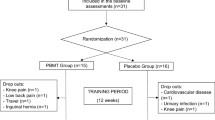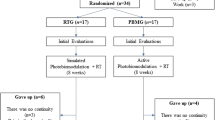Abstract
Photobiomodulation therapy (PBMT) has been used to improve the physical performance of individuals with advanced age; however, there are no studies in the literature that support the application of light-emitting diode (LED) therapy for the muscular performance of individuals with diabetes mellitus who show a decline in functionality. The aim of the study was to analyze the acute effects of PBMT on strength and functional performance in type 2 diabetic individuals. Sixty-three volunteers were recruited and randomized into five groups: control (C), sham (S), red LED (R), infrared LED (IR), and red LED + infrared LED (R + IR). On the first day, the volunteers were evaluated using the time up and go (TUG), the 6-min walk test (6MWT), and isokinetic dynamometer of the ankle. In the following 3 days, groups R, IR, R + IR, and S returned for application of PBMT bilaterally, with 180 J of energy on each leg. On the fifth day, a reassessment was performed. There was no statistical difference between groups for the variables of the isokinetic dynamometer, TUG, and 6MWT. Analysis of the size of the clinical effect for the isokinetic variables showed that there was no pattern among the effects observed. There is a moderate effect in favor of R, IR, and R + IR in relation to C for the TUG and a moderate effect of R + IR in relation to C for the 6MWT. The PBMT applied for a short period does not bring important gains for the muscular performance and functionality of diabetic individuals.


Similar content being viewed by others
References
Karu T (1999) Primary and secondary mechanism of action of visible to near-IR radiation on cells. J Photochem Photobiol B Biol 49:1–17
Hamblin MR (2018) Mechanisms and mitochondrial redox signaling in photobiomodulation. Photochem Photobiol 94(2):199–212
Karu T (2010) Multiple roles of cytochrome c oxidase in mammalian cells under action of red and IR-A radiation. IUBMB Life 62(8):607–610
Freitas LF, Hamblin MR (2016) Proposed mechanisms of photobiomodulation or low-level light therapy. IEEE J Sel Top Quantum Electron 22(3):348–364
Nicholls DG (2002) Mitochondrial function and dysfunction in the cell: its relevance to aging and aging-related disease. Int J Biochem Cell Biol 34(11):1372–1381
Toma RL, Vassão PG, Assis L, Antunes HK, Renno AC (2016) Low level laser therapy associated with a strength training program on muscle performance in elderly women: a randomized double blind control study. Lasers Med Sci 31(6):1219–1229
de Carvalho G, Gobbi A, Gobbi RB, Alfredo DMN, do Carmo Furquim TH, Barbosa RI, Papoti M, de Jesus Guirro RR (2020) Photobiomodulation by light emitting diode applied sequentially does not alter performance in cycling athletes. [published online ahead of print, 2020 Feb 20]. Lasers Med Sci
Nampo FK, Cavalheri V, Dos Santos Soares F, de Paula Ramos S, Camargo EA (2016) Low-level phototherapy to improve exercise capacity and muscle performance: a systematic review and meta-analysis. Lasers Med Sci 31(9):1957–1970
Leal-Junior EC, Vanin AA, Miranda EF, de Carvalho Pde T, Dal Corso S, Bjordal JM (2015) Effect of phototherapy (low-level laser therapy and light-emitting diode therapy) on exercise performance and markers of exercise recovery: a systematic review with meta-analysis. Lasers Med Sci 30(2):925–939
Brazilian Diabetes Society guidelines: 2014–2015 / Brazilian Diabetes Society; [organization Jose Egidio Paulo de Oliveira, Sergio Vencio].– Sao Paulo: AC Farmaceutica, (2015). https://www.diabetes.org.br/publico/images/2015/area-restrita/diretrizes-sbd-2015.pdf
Brazil. Ministry of Health. Department of Health Care. Department of Primary Care. Strategies for the care of people with chronic illness: diabetes mellitus. Brasília, (2013). (Primary Care Notebooks,n.36). https://bvsms.saude.gov.br/bvs/publicacoes/estrategias_cuidado_pessoa_diabetes_mellitus_cab36.pdf
Anton SD, Karabetian C, Naugle K, Buford TW (2013) Obesity and diabetes as acceleration of functional decline: can lifestyle interventions maintain functional status in high risk older adults? Exp Gerontol 48(9):888–897
Park SW, Goodpaster BH, Strotmeyer ES, de Rekeneire N, Harris TB, Schwartz AV, Tylavsky FA, Newman AB (2006) Decreased muscle strength and quality in older adults with diabetes. Diabetes Care 55(6):1813–1818
Lang IA, Llewellyn DJ, Alexander K, Melzer D (2008) Obesity, physical function, and mortality in older adults. J Am Geriatr Soc 56(8):1474–1478
Rekeneire N, Volpato S (2015) Physical function and disability in older adults with diabetes. Clin Geriatr Med 31:51–65
Ferreira JP, Sartor CD, Leal ÂM, Sacco IC, Sato TO, Ribeiro IL, Soares AS, Cunha JE, Salvini TF (2017) The effect of peripheral neuropathy on lower limb muscle strength in diabetic individuals. Clin Biomech (Bristol, Avon) 43:67–73
Farrag A, Elsayed W (2016) Habitual use of high-heeled shoes affects isokinetic soleus strength more than gastrocnemius in healthy young females. Foot Ankle Int 37:1–9
Podsiadlo D, Richardson S (1991) The timed “up & go”: a test of basic functional mobility for frail elderly persons. J Am Geriatr Soc [Internet] 39(2):142–148
Crapo RO, Casaburi R, Coates AL, Enright PL, MacIntyre NR, McKay RT et al (2002) ATS statement: guidelines for the six-minute walk test. Am J Respir Crit Care Med 166(1):111–117
de Jesus Guirro RR, de Carvalho G, Gobbi A, de Oliveira Assunção FF, de Souza Borges NC, Bachmann L (2020) Measurement of physical parameters and development of a light emitting diodes device for therapeutic use. J Med Syst 44(4):88
Krause MP, Riddell MC, Hawke TJ (2011) Effects of type 1 diabetes mellitus on skeletal muscle: clinical observations and physiological mechanisms. Pediatr Diabetes 12:345–364
Kelley DE, He J, Menshikova EV, Ritov VB (2002) Dysfuntion of mitochondria in human skeletal muscle in type 2 diabetes. Diabetes 51(10):2944–2950
Leal-Junior ECP, Lopes-Martins RÁB, Bjordal JM (2019) Clinical and scientific recommendations for the use of photobiomodulation therapy in exercise performance enhancement and post-exercise recovery: current evidence and future directions. Braz J Phys Ther 23(1):71–75
Toma RL, Tucci HT, Antunes HK, Pedroni CR, de Oliveira AS, Buck I, Ferreira PD, Vassão PG, Renno AC (2013) Effect of 808 nm low-level laser therapy in exercise-induced skeletal muscle fatigue in elderly women. Lasers Med Sci 28(5):1375–1382
Vassão PG, Toma RL, Antunes HK, Tucci HT, Renno AC (2016) Effects of photobiomodulation on the fatigue level in elderly women: an isokinetic dynamometry evaluation. Lasers Med Sci 31(2):275–282
Tucci HT, Figueiredo DS, de Paula Carvalho R, Souza ACF, Vassão PG, Renno ACM, Ciol MA (2019) Quadriceps femoris performance after resistance training with and without photobiomodulation in elderly women: a randomized clinical trial. Lasers Med Sci 34(8):1583–1594
Llewelyn JG (2003) The diabetic nerophaties: types, diagnosis and management. J Neurol Neurosurg Psychiatry 74(2):15–19
Fritsch CG, Dornelles MP, Teodoro JL, da Silva LXN, Vaz MA, Pinto RS, Cadore EL, Baroni BM (2019) Effects of photobiomodulation therapy associated with resistance training in elderly men: a randomized double-blinded placebo-controlled trial. Eur J Appl Physiol 119(1):279–289
Oberbach A, Bossenz Y, Lehmann S, Niebauer J, Adams V, Paschke R, Schön MR, Blüher M, Punkt K (2006) Altered fiber distribution and fiber-specific glycolytic and oxidative enzyme activity in skeletal muscle of patients with type 2 diabetes. Diabetes Care 29(4):895–900
Ferraresi C, Huang YY, Hamblin MR (2016) Photobiomodulation in human muscle tissue: an advantage in sports performance? J Biophotonics 9(11–12):1273–1299
Vanin AA, Verhagen E, Barboza SD, Costa LOP, Leal-Junior ECP (2018) Photobiomodulation therapy for the improvement of muscular performance and reduction of muscular fatigue associated with exercise in healthy people: a systematic review and meta-analysis. Lasers Med Sci 33(1):181–214
Funding
This study was financed in part by the Coordenação de Aperfeiçoamento de Pessoal de Nível Superior—Brasil (CAPES)—Finance Code 001 and Process No. 2017/13997-4 of Fundação de Amparo à Pesquisa do Estado de São Paulo (FAPESP).
Author information
Authors and Affiliations
Corresponding author
Ethics declarations
Conflict of interest
The authors declare that they have no conflicts of interest.
Ethics approval
Comitê de Ética em Experimentação com Seres Humanos do Hospital das Clínicas—FMRP/USP (no. 3.805.967).
Additional information
Publisher’s note
Springer Nature remains neutral with regard to jurisdictional claims in published maps and institutional affiliations.
Rights and permissions
About this article
Cite this article
Gobbi, A., de Carvalho, G., Sapalo, A.T. et al. Acute application of photobiomodulation does not bring important gains for the muscular performance and functionality of diabetic individuals. Lasers Med Sci 36, 995–1002 (2021). https://doi.org/10.1007/s10103-020-03135-7
Received:
Accepted:
Published:
Issue Date:
DOI: https://doi.org/10.1007/s10103-020-03135-7




